Prevalence of altered cervical cytological pattern: Aretrospective study in females visiting tertiary care hospital
Abstract
Background: Cervical cancer is one of the major causes of morbidity and mortality in India. Pap smear is a simple, non-invasive, cost-effective and sensitive tool to detect various non-neoplastic and neoplastic lesions of cervix. The objective of this study was to estimate the prevalence of cervical cytological pattern in a tertiary care centre; by using conventional Papanicolaou (Pap) smears for the screening of inflammatory, premalignant and malignant lesions of the cervix.
Methods: This cross-sectional study is based on 574 patients who attended the out‑patient Department of Obstetrics and Gynecology, during the period between Jan 2015 to Feb 2017. Pap smears were prepared from patients presenting with complaints like vaginal discharge, post‑coital bleeding, inter‑menstrual bleeding, dyspareunia, and pain in lower abdomen. Conventional Papanicolaoustained smears were classified as per Bethesda 2001 nomenclature.
Results: Prevalence of altered cervical cytological pattern was 75.59% amongst females visiting hospital. A total of 574 cervical pap smears were studied, out of which 66 were inadequate. Out of 508 cases, 448 cases were of NILM [including 324 (63.78%) inflammatory lesions and 124 (24.41%) normal smears] and 60 (11.81%) cases of epithelial lesions. The epithelial lesions prevalence rate was ASCUS (5.7%), LSIL (1.4%) and HSIL (1.4%), AGUS (0.78%), SCC (0.6%) and endometrial carcinoma (0.2%).
Conclusions: This study shows relatively high prevalence of epithelial abnormalities with increasing age, parity, women with clinical lesions on per speculum findings. Malignancy was more common in sixth and seventh decade and intraepithelial lesions/dysplasia was seen mostly in fourth and fifth decade. Inflammatory lesions were more common in younger age group. Pap smear should be advised as a routine screening procedure; as it is a simple, cheap, safe and practical diagnostic tool for early detection of cervical cancer in high risk group population. It also helps in diagnosis of inflammatory lesions including the identification of causative organism and atrophic changes.
Downloads
References
2. Thirumurugan. P, Premila.E, Suresh Kanna. K, Study of early detection of cervical cancer by PAP’s smear in selected setting of Puducherry.Asia Pacific Journal of Research. Vol: I. Issue XXXIV, December 2015:156- 160.
3. VaghelaBV; VaghelaVK.; SantwaniPM. Analysis of abnormal cervical cytology inPapanicolaou smears at tertiary care center – A retrospective study. International Journal of Biomedical and Advance Research, [S.l.], v. 5, n. 1, p. 47-49, Jan. 2014. ISSN 2229-3809.
4. Bal MS, Goyal R, Suri AK, Mohi MK. Detection ofabnormalcervical cytology in Papanicolaou smears. J Cytol2012;29:45-7.
5. Anderson and Jones: false positive cervicovaginal cytology. acta cytol41(6):267,1997. [PubMed]
6. Solomon D, Davey D, Kurman R et al. The 2001 Bethesda system: Terminology for reporting results of cervical cytology. JAMA.2002;287:2114-9.
7. B. Sandhya Rani. Cervical Pap Smear Study for Screening of Pre-Cancerous Conditions of Cervix. IAIM, 2018; 5(1): 138- 144.
8. Saha D, Ghosh S, NathS,Islam H. Utility of Pap smear screening for prevention of cervical cancer- A 3yrs studyfrom rural Tripura – Anortheastern state of India. Int J Med and Dent Sci. 2017;6(2):1456-1461.
9. Patel MM, Pandya AN, Modi J. Cervical papsmear study and its utility in cancer screening, to specify the strategy for cervical cancer control. National Journal of Community Medicine. 2011;2(1):49-51.
10. Rawat K etal.A study of cytological pattern of cervical papanicolaousmears in western Rajasthan, IndiaInt JReprodContraceptObstet Gynecol. 2016 Sept;5(9):3186-3190.
11. Gupta S, Sodhani P, Halder K, ChachraKL,Singh V, Sehgal A. Age trends in pre-cancerous and cancerous lesions of the uterine cervix in a cytologyscreeningprogramme: what should be the target age group for a major thrust of screening in resource limited settings? Cytopathology. 2008;19(2):106-10.
12. Anindita Sinha Babu, Manisha Sarkar, Dipanwita Das. Spectrum of cervical lesions in papanicolaousmears examination in a new tertiary care centre.International Journal of Contemporary Medical Research. 2017;4(9):1986- 1990.
13. Sharma P, Rahi M, Lal P.A Community-based Cervical Cancer Screening Program among Women of Delhi using Camp Approach. Indian J Community Med., 2010; 35(1): 86-8.
14. Malpani G et al.Cervical Pap smear study and detection of abnormal epithelial lesions and determination of its accuracy by cytohistological correlation in patients of tertiary care teaching hospital in central India.Int J ReprodContraceptObsteGynecol.2016;5:2312-6.
15. Tailor HJ, Patel RD, Patel PR, Bhagat VM. Study of cervical pap smears in a tertiary care hospital of south Gujarat, India.Int J Res Med Sci. 2016;4:286-288.



 OAI - Open Archives Initiative
OAI - Open Archives Initiative


